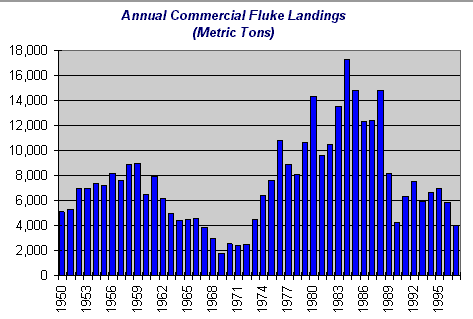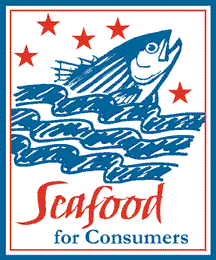
Number 3
October 7, 1998

 |
 |
The summer flounder, also called fluke (Paralicthys dentatus), is one of the most popular fish with both recreational anglers and seafood lovers in the Mid-Atlantic region and southern New England. Historically the total catch of this highly desirable flatfish has been about evenly divided between the sports and commercial harvesting sectors, contributing hundreds of millions of dollars to the coastal economy of the region every year. The fishery has been the mainstay of a large part of the party/charter boat fleet and many commercial boats, both large and small, for generations.
Like many fish species, the numbers - and the landings - of fluke tend
to fluctuate widely. As the chart below shows, in the 47 years beginning
in 1950 commercial fluke landings, which averaged about 6,200 metric tons
a year for the total period, ranged from a low of 1,782 tons in 1969 to
a high of 17,255 tons in 1984 - a variation of an order of magnitude. (recreational
landings, which were only available beginning in 1981, show the same pattern
of variation.)
 |
Responding to what was represented by the management establishment as an imminent collapse of the fluke stocks in the early 1990s, severe restrictions were placed on both the recreational and commercial harvest. The commercial landings, 4246 tons in 1990, bounced back up to 6291 tons in 1991 - production equal to the average landings for the fishery since 1950. Ignoring the low 1990 landings, the only indication of any “collapse” of the fishery evidenced in commercial landings would be their declining to a level that is almost exactly the 48 year average.
To prevent the “imminent collapse,” restrictions on commercial harvesters included a small coastwide quota implemented on a state-by-state basis, an increased minimum fish size and a minimum net mesh.
Each state was granted a commercial quota and the authority to decide how to allocate it among the permitted harvesters. New Jersey divided the year into three seasons with a part of the statewide quota available at the beginning of each season and the season remaining open until all of that part of the quota was caught. To fairly divide the harvest between the larger and smaller boats allowed to land fish in New Jersey, per-trip catch limits, which vary from season to season, were also established. The entire New Jersey quota for the season which opened on September 1, 1998 was taken within three weeks.
The angling measures put in place to meet target fluke mortality levels in response to the perceived crisis were both bag and size limits. Due to an oversufficiency of the supposedly threatened species, in 1996 the sportsfishing target quota was exceeded by almost 50% and in 1997 by about 60%. Projections are that in 1998 the target quota may be exceeded by 100%.
In the commercial fluke fishery….
Taking all of the restrictions on the commercial fluke fishery into account, the boats are employing perhaps a quarter of the total fishing power that was directed at fluke a decade or two ago. Back then there were no limits on how many boats could participate in the fishery. They could fish with any type of gear for up to 365 days a year (realistically, a boat could fish for fluke off New Jersey for at least 200 days a year, depending on its size) and keep any size of fish that could be sold. At the time there was a large market for what are now sub-legal fluke so many of the smaller fish were kept. .
Today the New Jersey fluke boats fish less than 40 days a year, using nets with a mesh that allows the smaller fluke to escape, and the reduced number of boats is strictly limited. Yet even with these restrictions the much smaller fleet is able to catch half as many fish as it did in the unregulated fishery of years past in much less than half the time. Given this level of fishing success and looking at the landings patterns, it’s difficult to see the crisis that supposedly necessitated such drastic restrictions on fishing .
As a result of this management regime, what used to be a year round
supply of highly desirable fluke fillets has become sporadic and unpredictable.
Many dealers have been forced to switch to imported flatfish, a move that
has driven down the price paid to our fishermen for their fish. Fluke used
to be one of the most valuable species landed in the Mid-Atlantic. Today,
thanks to a management system that is completely insensitive to the realities
of international seafood marketing, it doesn’t return any more to the fishermen
than any of the other commonly caught species. By being restricted
to catching less fish and getting lower prices for those they do catch,
the domestic fleet is suffering a “double whammy” and they are suffering
it at a time when the ocean is arguably filled with fluke.
And the recreational….
The past several years have shown a resurgence in the recreational
fluke, striped bass and weakfish fisheries. There hasn’t been a redirecting
of angling effort to account for a greater fluke catch. A notably high
number of large fluke have been caught this year (see box on right) but
other sizes have also been available to anglers. The inescapable conclusion
is that there are a lot of fluke waiting to be caught.
In spite of what seems to be compelling evidence - at least considering the catch in the commercial and sports fisheries - that fluke stocks have undergone a dramatic recovery (assuming that a collapse really was imminent when the “doom and gloom” machine focused on this species a few years back), several environmental oganizations have petitioned the management establishment to “save fluke” even more severely by completely closing the recreational fishery. Some commercial fishing organizations have also joined this effort, but their motivation is that if the recreational harvest continues at high levels and overall quotas aren’t adjusted, the commercial quota will be reduced to compensate.
The question that most immediately comes to mind is “how much saving does the fluke fishery really need?” Looking at both the commercial and the recreational fisheries, it appears as if there are - and have been for several years - more than enough fluke to go around. In fact, knowledgeable fishermen argue there are more fluke available than there have been for years. But in spite of this, and propped up by statistical models based largely on commercial and recreational catch data that intuitively screams otherwise, fisheries managers - with reinforcements provided by the environmental community - are insisting that the fishery has not recovered and that even more stringent restrictions are in order. Existing restrictions are already draining many millions of dollars from the economies of the coastal states from North Carolina to Massachusetts. If the environmentalists are successful in their efforts, this will increas by millions more. And their justification is that too many fluke are being caught. In some sort of fisheries Catch 22, the fact that they’re only being caught because they’re so plentiful counts for nothing.
While at first glance this seems to be a subject important only in the
Mid-Atlantic, it is actually symptomatic of problems in many other U.S.
fisheries. Management decisions are increasingly based on measures of fishing
performance (cheap) rather than direct observations of fish in the oceans
(expensive). However, fishing performance - both commercial and recreational
- is dependent on many more factors than the condition of the stocks. The
thousands of dollars we’re saving in scrimping on at-sea observations are
costing millions of dollars in lost economic activity. This is a false
economy we can’t afford.
| NOTE: In spite of the controversy about the condition of the fluke stocks (and the millions of dollars that depend on that condition), at the Mid-Atlantic Fishery Management Council meeting in Philadelphia on October 6, the National Marine Fisheries Service wasn’t willing to commit to an immediate stock assessment, which would very possibly bring their statistics more in line with fishermen’s observations. |

![]()
New Jersey FishNet is supported by Atlantic Capes Fisheries, the Fishermen’s Dock Cooperative, Lund’s Fisheries, Export, Inc., Agger Fish Corp., the National Fisheries Institute and Viking Village Dock